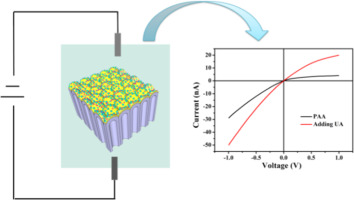Electrochemistry Communications ( IF 4.7 ) Pub Date : 2018-10-19 , DOI: 10.1016/j.elecom.2018.10.017 Tiantian Su , Lei He , Rijian Mo , Chunxia Zhou , Zhe Wang , Yi Wang , Pengzhi Hong , Shengli Sun , Chengyong Li

|
Porous anodic alumina (PAA) membranes have attracted considerable interest in biosensor research because they are simple to prepare and the size of the nanochannels can be controlled. However, traditional methods only utilize the porous layer as the barrier layer is removed before use. In this study, we propose a new biosensor for the detection of uric acid based on ion channels in the barrier layer of a PAA membrane. This exhibits a wide linear range (1 nM–0.1 mM) and has excellent selectivity in the presence of interferents (d‑(+)‑glucose, l‑ascorbic acid or dopamine). It is hoped that this new biosensor will prove useful in biological research and clinical medicine.
中文翻译:

一种在多孔阳极氧化铝膜的阻隔层中利用离子通道的非酶促尿酸传感器
多孔阳极氧化铝(PAA)膜在生物传感器研究中引起了相当大的兴趣,因为它们易于制备并且可以控制纳米通道的大小。然而,传统方法仅利用多孔层,因为在使用之前去除了阻挡层。在这项研究中,我们提出了一种新的生物传感器,用于基于PAA膜阻隔层中的离子通道检测尿酸。它具有宽线性范围(1 nM–0.1 mM),并且在存在干扰物(d -(+)-葡萄糖,l-抗坏血酸或多巴胺)的情况下具有出色的选择性。希望这种新型生物传感器将在生物学研究和临床医学中被证明是有用的。











































 京公网安备 11010802027423号
京公网安备 11010802027423号